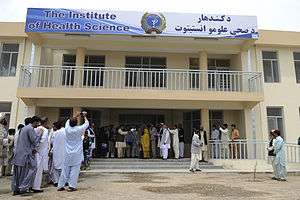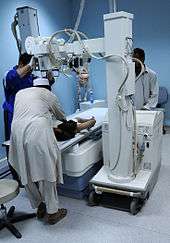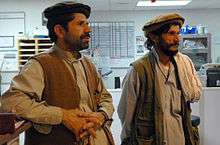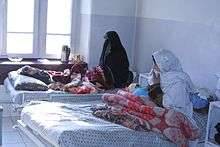Health in Afghanistan

Health in Afghanistan is in need of improvement due to the country being in a state of civil war for the last three decades. According to the Human Development Index, Afghanistan is the 15th least developed country in the world. The Ministry of Public Health deals with matters concerning the health of Afghanistan's population.
After Operation Enduring Freedom in late 2001, when the United Nations began focusing on the situation in Afghanistan, improvement slowly began in the health care system of the country.[1] According to USAID, infant mortality rate has decreased by 22% and child mortality has dropped by 26% since 2003. It was reported in 2006 that nearly 60% of the population lives within two hours walking distance of the nearest health facility, up from nine percent in 2002.[2]
The average life expectancy at birth is reported at around 60 years for both sexes.[3][4][5] In 2013, Harvard Medical school and NATO published a report on the impact of the conflict on the Afghan health system.[6]
History

Beginning in 1979, military conflict destroyed the health system of Afghanistan. Most medical professionals left the country by 1992, and all medical training programs ceased. In 2003, there were 11 physicians and 18 nurses per 100,000 population, and the per capita health expenditure was $28 US dollars. The nation had one medical facility for every 27,000 people in 2004, and some centers were responsible for as many as 300,000 people. An estimated one-quarter of the population had no access to health care. The international organizations provided a large share of medical care. The drought of 1999–2002 exacerbated these conditions. An estimated 800,000 Afghans are disabled.[7]

Infant, child, and maternal mortality rates in Afghanistan reached the highest in the world, by some estimates as high as 275 per 1,000. In rural areas, one in six children die before reaching age five. This is because of poor sanitation and insufficient potable water supply, infectious and parasitic diseases such as malaria and diarrhea are very common. Malnutrition and poor nutrition also are pervasive.
User fees have been a major deterrent to accessing health care. Various interventions have been devised to improve uptake of health care services, including the distribution of waiver cards to very poor and female-headed households[8] and the introduction of community-based health insurance.[9]
Following the national user fee ban in 2008, a pilot study conducted by the Future Health Systems consortium found a 400% increase in utilization of services that had previously charged fees for services and medicine.[10] The government's strategy to collaborate with non-governmental organisations[11] has led to higher primary health outcomes among the poor,[12] with relatively high levels of perceived health care quality reported by clients in a recent study of primary care services.[13]
The physical and psychological effects of war have substantially increased the need for medical care. In the last decade a number of new hospitals were established, with the most advanced treatments being available in Kabul. The French Medical Institute for Children and Indira Gandhi Childrens Hospital in Kabul are the leading children's hospitals in the country. Some of the other main hospitals in Kabul include the 350-bed Jamhuriat Hospital, the Sardar Mohammad Daud Khan Hospital,[14] and the Jinnah Hospital, which is still under construction. There are also a number of well-equipped military controlled hospitals in different regions of the country. 2011 surveys show that 57 percent of Afghans say they have good or very good access to clinics or hospitals,[15] and Afghans themselves pay approximately 75% of health care costs directly.[16]
Health status
Tuberculosis
Tuberculosis is endemic in Afghanistan, with over 76,000 cases reported per year. The United States Agency for International Development is engaged in promulgating DOTS (directly observed therapy, short course) treatments, as well as TB awareness and prevention.[17]
BRAC is a development organisation that focuses on the alleviation of poverty through the empowerment of the poor to improve their lives. BRAC Afghanistan is involved in assisting Afghan Ministry of Public Health in the implementation of the Basic Package of Health Services (BPHS) in Kabul, Badghis, Balkh and Nimroz. This implementation is mainly funded by the World Bank and the USAID-REACH (United States Agency for International Development - Rural Expansion of Afghanistan Community-based Healthcare).
Tuberculosis is a serious public health problem in Afghanistan. In 2007, 8,200 people in the country died from tuberculosis and, in the WHO's Global Tuberculosis Control Report 2009, an annual estimated figure of 46,000 new cases of tuberculosis were in Afghanistan. As such, Afghanistan is ranked 22nd in amongst highly affected Tuberculosis countries.[18]
To help control tuberculosis, BRAC Afghanistan started the community-based TB DOTS under the Fund for Innovative DOTS Expansion through Local Initiatives to Stop TB (FIDELIS) project in 2006. In the first phase of this programme, diagnostic facilities for tuberculosis were expanded through the setting up of 50 TB microscopy centres. This phase lasted from January 2006 and up to March 2007. Over the next two years, facilities were further expanded and 92 more Tuberculosis Microscopy Centres were set up under the FIDELIS programme.[19]
The Tuberculosis Control Assistance Programme (TB CAP) is another project taken up between BRAC Afghanistan, World Health Organization (WHO) and Management Sciences for Health (MSH) in a bid to fight TB in Afghanistan. In this project, BRAC Afghanistan supports the BPHS (Basic Package of Health Services) project by replicating the CB-DOTS model into health systems of four provinces: Baghlan, Jawzjan, Badakshan and Herat. BRAC Afghanistan was selected as Principal Recipient (PR) for malaria and TB components of the Global Fund 8.[20]
In 2009, 2,143,354 patients received treatment under the health programs mentioned. As of August 2010, BRAC Afghanistan had covered 388 districts and 25 million of the total population are under the BRAC Afghanistan Health Program. Health facilities also include six District Hospitals, 26 Comprehensive Health Centres, 53 Basic Health Centres, 18 Sub Health Centres as well as 533 Mobile Clinics every month.[21]
HIV
According to Soraya Dalil, Minister of Public Health, "the fastest method of HIV and AIDS spread is the use and sharing of injections by drug addicts. A recent data shows a 7.1 percent HIV/AIDS prevalence rate in three urban centers, where 85 percent of drug users share needles."
According to reliable scientific studies, the prevalence of HIV in Afghanistan is much lower, i.e., less than 1% (Todd CS, 2012 and 2008).[22][23]
In 2006 the United Nations Development Programme estimated that an HIV/acquired immune deficiency syndrome (AIDS) epidemic could occur in Afghanistan because of the high incidence of intravenous drug use, unsafe blood transfusion procedures, massive refugee repatriation, poor health facilities, and illiteracy.[7] According to Afghanistan's National Aids Control Program (NACP), 504 cases of HIV/AIDS were documented in late 2008.[24] By 2011 the numbers reached 1,250. Health officials estimate that between 2,000 and 3,000 people may be living with the virus.[23][25] About 11 people, most of them drugs addicts, have died in Afghanistan from AIDS.[23]
Poliomyelitis
Afghan Ministry of Public Health along with World Health Organization and UNICEF are engaged in a campaign to eliminate polio in the country. Wild poliovirus is present in Afghanistan, though in limited areas. Reported cases were on the decline, from 63 in 1999 to 17 in 2007, until increased violence in 2008 impeded vaccination efforts, causing cases to climb to 20 for the first nine months of 2009. Afghanistan, the remaining country where polio is endemic. Most of Afghanistan is polio-free. The country has not yet interrupted transmission of wild poliovirus. While most cases in 2014, 2015 and 2016 were due to poliovirus imported from neighbouring Pakistan, there is also ongoing transmission of virus within Afghanistan. In 2015 and from January/2016 to September/ 2016. Afghanistan had a major reduction in WPV cases. The majority of cases were reported from Nangarhar province in eastern Afghanistan, which borders Pakistan, and were genetically linked to cases in Pakistan. Afghanistan reported 20 cases in 16 districts in 2015, compared with 28 cases in 19 districts in 2014, and 8 cases in 2016, The most recent case had onset of paralysis on 8 August/2016, from Kabul.
Malnutrition
More than half of Afghan girls and boys suffer damage to their minds and bodies that cannot be undone because they are poorly nourished in the crucial first two years of life. High levels of Malnutrition in Children is rate of stunting 60.5%, One third of children (33.7%) underweight, Anaemia 50% in children 6–24 months, High iodine deficiency: 72%(school age) and also the high levels of Malnutrition in Women is Iron deficiency: 48.4%, non-pregnant and Iodine deficiency 75%.and high levels of chronic energy deficiency are 20.9% low BMI. Supporting the Implementation of Nutrition (and Health)-Specific Interventions through BPHS and EPHS. The Ministry of Public Health, World Bank and WFP are working together for ensuring that mothers are healthy before they become pregnant and throughout pregnancy, promoting appropriate Infant and Young Child Feeding Practices, ensuring that children receive adequate health care to prevent growth faltering resulting from illness and early treatment of acute malnutrition and Promote appropriate hygiene practices.
Leprosy
Despite anti-leprosy initiatives by Leprosy Control (LEPCO) dating to 1984, leprosy is present in Afghanistan, with 231 cases reported in the 2001-2007 period. Just over three-quarters of the cases were the MB-type, with the rest PB-type. Leprosy has been reported in the central Hindu Kush mountain area of the country. Mainly in the provinces of Bamyan, Ghazni, Balkh.[26]
Typhoid fever
Being the 15th least developed country in the world, Afghanistan faces difficulties in sanitation. In urban areas 40% of the population have unimproved access to sanitation facilities. Because of this many Afghanistan natives are forced to combat typhoid fever. Typhoid fever is one of Afghanistan's major infectious diseases in terms of food/waterborne diseases. This infectious disease occurs when fecal material comes into contact with food or water. Symptoms vary from case to case but often mild fever is present and if left untreated death may occur.[27]
Hepatitis A
Sanitation issues place the Afghanistan population at risk of contracting hepatitis A through the consumption of food and water that has been contaminated by fecal material. Hepatitis A works by inhibiting the liver from functioning properly. Symptoms generally include jaundice, fatigue, loss of appetite, while some victims may experience diarrhea. Furthermore, symptoms will appear 2–6 weeks after an individual has come into contact with the hepatitis A virus.[27]
Leishmaniasis
Visceral leishmaniasis infections are often recognised by fever, swelling of the liver and spleen, and anemia. They are known by many local names, of which the most common is probably Kala azar,.[28][29] A total of 21 cases of VL acquired in Afghanistan, all in the 1980s according to CDC reporting.[30]
Maternal and child health care

An improvement in child health services in 500 - 600 health facilities was noted in 2006. The improvement correlates with the presence of clinical guidelines and the frequency of supervision of health care providers.[31] A 2008 study indicated that 13% of respondents had used skilled birth attendants.[32]
By 2010, the maternal mortality rate per 100,000 births for Afghanistan was 1,400. The under 5 mortality rate, per 1,000 births was 201 and the neonatal mortality as a percentage of under 5's mortality was 27.[33]
Afghanistan has more than 3,000 midwives with an additional 300 to 400 being trained each year.[34] About 1 in 50 women die while giving birth and the number of children who died before the age of 5 is about 1 in 10. According to Sima Ayubi, a maternity doctor in Kabul who advocates hospital births, explains: "Now pregnant women have more information about health. This mortality rate is still a problem. There's just a decrease. The problem is not completely eliminated or under control."[15]
According to a 2012 report by Save the Children, improved healthcare and the rise of females attending school have made Afghanistan climb up from its position as the worst place on earth to be a mother."More mothers are surviving and fewer children are dying and this is something we need to be celebrating," said Rachel Maranto, Advocacy and Mobilisation senior Manager at Save the Children in Kabul. Despite the better healthcare, about 275 children die every day in the country of 30 million.[35]
See also
- Ministry of Public Health (Afghanistan)
- Water supply in Afghanistan
- Environmental issues in Afghanistan
References
- ↑ "Health". Pajhwok Afghan News. Retrieved 2010-10-20.
- ↑ "Health". United States Agency for International Development (USAID). Retrieved October 20, 2010.
- ↑ "Life expectancy in Afghanistan rises past 60 years". Pajhwok Afghan News. November 30, 2011. Retrieved December 5, 2011.
- ↑ Mohammad Jawad Sharifzada, ed. (November 20, 2011). "Afghanistan's population reaches 26m". Pajhwok Afghan News. Retrieved December 5, 2011.
- ↑ "Afghanistan". World Health Organization (WHO). Retrieved 2013-07-06.
Life expectancy at birth m/f (years) 59/61
- ↑ https://www.jallc.nato.int/newsmedia/docs/afghanistan_case_study.pdf
- 1 2 Afghanistan country profile. Library of Congress Federal Research Division (May 2006). This article incorporates text from this source, which is in the public domain.
- ↑ Steinhardt, Laura; David Peters (2010). "Targeting accuracy and impact of a community-identified waiver card scheme for primary care user fees in Afghanistan". International Journal for Equity in Health. 9 (28). doi:10.1186/1475-9276-9-28. Retrieved 18 May 2012.
- ↑ Rao, K; et al. (27 May 2009). "An Experiment with Community Health Funds in Afghanistan". Health Policy and Planning. Retrieved 26 May 2012.
- ↑ Steinhardt, Laura; Iqbal Aman; Iqbalshah Pakzad; Binay Kumar; Lakhwinder Singh; David Peters (2011). "Removing user fees for basic health services: a pilot study and national roll-out in Afghanistan". Health Policy and Planning. 26 (Suppl 2): ii92–ii103. doi:10.1093/heapol/czr069. Retrieved 18 May 2012.
- ↑ Arur, A; et al. (22 October 2009). "Contracting for Health and Curative Care Use in Afghanistan Between 2004 and 2005". Health Policy and Planning. Retrieved 26 May 2012.
- ↑ Hansen, Peter; et al. (2008). "Determinants of Primary Care Service Quality in Afghanistan". Int J Qual Health Care. 20 (6): 375–383. doi:10.1093/intqhc/mzn039. Retrieved 26 May 2012.
- ↑ Hansen, Peter; et al. (2008). "Client Perceptions of the Quality of Primary Care Services in Afghanistan". Int J Qual Health Care. 20 (6): 384–391. doi:10.1093/intqhc/mzn040. Retrieved 26 May 2012.
- ↑ Rivera, Ray; Sahak, Sharifullah (21 May 2011). "Blast Hits Military Hospital in Afghan Capital". The New York Times.
- 1 2 Childbirth and maternal health improve in Afghanistan, by Tom A. Peter. Christian Science Monitor. Dec. 17, 2011.
- ↑ Renee Montagne (2011-12-21). "USAID Helps To Improve Medical Care In Afghanistan". NPR. Retrieved 2012-01-16.
- ↑ "Bringing Hope to Tuberculosis Patients". United States Agency for International Development (USAID). Retrieved 2010-10-20.
- ↑ Chris Thomas, Global Health/Health Infectious Diseases and Nutrition (2009-09-22). "USAID Health: Infectious Diseases, Tuberculosis, Countries, Afghanistan". USAID. Retrieved 2011-08-29.
- ↑ "DOTS". Tbalert.org. Retrieved 2011-08-29.
- ↑ SWiSH v2.0. "BRAC Afghanistan (Bangladesh)- Community Based Health Program". Bracafg.org. Retrieved 2011-08-29.
- ↑ http://www.bracafg.org/report/At%20A%20Glance%20of%20BRAC%20Afghanistan%20as%20of%20August2010.pdf
- ↑ http://www.biomedcentral.com/1471-2334/8/11; http://www.biomedcentral.com/1471-2334/12/196
- 1 2 3 "50pc surge in HIV cases, says Dalil". Pajhwok Afghan News. December 3, 2011. Retrieved December 5, 2011.
- ↑ Children at risk of contracting HIV/AIDS in Afghanistan. December 1, 2008.
- ↑ Number Of New HIV Cases Reported In Afghanistan Increasing, Health Ministry Says. July 11, 2008.
- ↑ Leprosy Situation in Afghanistan in 2001-2006. Ministry of Public Health (MoPH) National Leprosy Control Program. 7–9 July 2008.
- 1 2 "Major infectious diseases". The World Factbook. Central Intelligence Agency. Retrieved April 4, 2007.
- ↑ Kala Azar
- ↑ kala-azar. The American Heritage Dictionary of the English Language
- ↑ . Two Cases of Visceral Leishmaniasis in U.S. Military Personnel
- ↑ Edward, A; et al. (2009). "Trends in the Quality of Health Care for Children Aged Less than 5 Years in Afghanistan, 2004 - 2006". Bullet World Health Organization. 940. Retrieved 26 May 2012.
- ↑ Mayhew (2008). "Determinants of skilled birth attendant utilization in Afghanistan: A cross-sectional study". American Journal of Public Health. 98: 1849–56. doi:10.2105/ajph.2007.123471.
- ↑ "The State Of The World's Midwifery". United Nations Population Fund. Retrieved August 2011. Check date values in:
|access-date=(help) - ↑ The State of the World's Midwifery
- ↑ "Afghanistan no longer worst place for mothers: report". Reuters. May 8, 2012. Retrieved May 8, 2012.
External links
| Wikimedia Commons has media related to Health in Afghanistan. |
- Pajhwok Afghan News - Health
- The State Of The World's Midwifery - Afghanistan Country Profile
- Harvard Medical School/NATO Healthcare project - Afghanistan Case Study